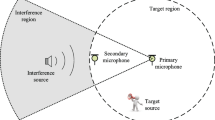Abstract
Multiple noise sources in a realistic environment severely degrade the quality and intelligibility of the desired speech signal, thus posing a severe problem for many speech applications. Several noise reduction algorithms have been proposed with a main goal to solve this problem. However, the good performances of such algorithms are severely impaired in realistic environment under multi-noise sources condition. In this paper, the author treats the noise cancellation system as a multiple-input multiple-output (MIMO) beamformer system. The proposed approach consists of two steps. First, the noise signals are generated by applying the white noise sources to a MIMO AR system. Then, the noisy microphone signals are sequentially processed by employing multi-channel linear prediction error filters (MCLPEFs) and multi-channel adaptive noise estimation filters (MCANEFs) in the lower path of the proposed beamformer. The MCLPEFs are used to whiten the input signals, while the MCANEFs are used as a MIMO system identification to perform the modeling process of the noise signals. Finally, the noise signals in the upper path are subtracted from the estimated noises in the lower path to recover an enhanced speech signal. Moreover, the performance of the proposed MIMO approach was validated under a realistic environment with real noise sources.











Similar content being viewed by others
References
Allen, J., & Berkley, D. A. (1979). Image method for efficiently simulating small room acoustics. Journal of the Acoustical Society of America, 66, 943–950.
Bitzer, J., Simmer, K. U., & Kammeyer, K. D. (1999). Theoretical noise reduction limits of the generalized sidelobe canceller (GSC) for speech enhancement. Proceeding of IEEE International Conference on Acoustics, Speech, and Signal Processing (ICASSP), 5, 2965–2968)
Delcroix, M., Hikichi, T., & Miyoshi, M. (2005). Blind dereverberation algorithm for speech signals based on multi-channel linear prediction. Acoustical Science and Technology, 26(5), 432–439.
Djendi, M. (2018). An efficient wavelet-based adaptive filtering algorithm for automatic blind speech enhancement. International Journal of Speech Technology, 21(2), 355–367.
Faucon, G., Mezalek, S. T., & Le Bouquin, R. (1989). Study and comparison of three structure for enhancement of noisy speech. Proceeding of IEEE International Conference on Acoustics, Speech, and Signal Processing, 1, 385–388.
Golub, G. H., & Van Loan, C. F. (1989). Matrix computations (2nd edn.). Baltimore: John Hopkins University Press.
Griffiths, L. J., & Jim, C. W. (1982). An alternative approach to linearly constrained adaptive beamforming. IEEE Transactions on Antennas and Propagation, 30(1), 27–34.
Harville, D. A. (1997). Matrix algebra from a statistician’s perspective. New York: Springer.
Haykin, S., & Kailath, T. (2002). Adaptive filter theory (4th edn.). Upper Saddle River, NJ: Prentice-Hall, Pearson Education, Inc.
Herbordt, W., Buchner, H., Nakamura, S., & Kellermann, W. (2007). Multichannel bin-wise robust frequency-domain adaptive filtering and its application to adaptive beamforming. IEEE Transactions on Audio, Speech, and Language Processing, 15(4), 1340–1351.
Herbordt, W., & Kellermann, W. (2003). Adaptive beamforming for audio signal acquisition. In J. Benesty & Y. Huang (Eds.), Adaptive signal processing: Applications to real-world problems (pp. 155–194). Berlin: Springer.
Hoshuyama, O., Sugiyama, A., & Hirano, A. (1999). A robust adaptive beamformer for microphone arrays with a blocking matrix using constrained adaptive filters. IEEE Transactions on Signal Processing, 47(10), 2677–2684.
Kailath, T., Sayed, A. H., & Hassidi, B. (2000). Linear estimation. Upper Saddle River, NJ: Prentice-Hall.
Linhui, Sun, Min, & Yang, SuZ. (2017). An adaptive speech endpoint detection method in low SNR environments. International Journal of Speech Technology, September, 20(3), 651–658.
Mohammed, H. S., Rihan, A. M., NassarAdel, M. A., El-Fishawy, S., & Abd El-Samie, E. (2017). Efficient compression and reconstruction of speech signals using compressed sensing. International Journal of Speech Technology, 20(4), 851–857.
Mohammed, J. R. (2009a). An efficient method for combining adaptive echo and noise canceller in hands-free systems. International Journal of Adaptive Control and Signal Processing, 23, 278–292
Mohammed, J. R. (2009b). Adaptive noise reduction and acoustic echo cancellation using adaptive filters in hands-free communication systems, PhD Thesis, Punjab Engineering College, Panjab University, Chandigarh, India, 20 November 2009.
Mohammed, J. R. (2017). Development of two-input adaptive noise canceller with ability to cancel wideband and narrowband noise signals. International Journal of Speech Technology, 20(3), 741–751.
National Instruments, LabVIEW Fundamentals, Version 8.0, User Manual, Part Number 324029A-01, August 2005.
Neubauer, R. O. (2001). Existing reverberation time formulae—a comparison with computer simulated reverberation times. In 8th International Congress on Signal and Vibration, Hong Kong, July, 2001 (pp. 805–812).
Rashmirekha, R., & Mohanty, M. N. (2018). Performance analysis of adaptive variational mode decomposition approach for speech enhancement. International Journal of Speech Technology, 21(2), 369–381.
Van Comprenolle, D. (1990). Switching adaptive filters for enhancing noisy reverberant speech from microphone array recordings. In Proceeding of IEEE ICASSP, Albuquerque NM, April 1990 (Vol. 2, pp. 833–836).
Author information
Authors and Affiliations
Corresponding author
Rights and permissions
About this article
Cite this article
Mohammed, J.R. MIMO beamforming system for speech enhancement in realistic environment with multiple noise sources. Int J Speech Technol 21, 671–680 (2018). https://doi.org/10.1007/s10772-018-9530-9
Received:
Accepted:
Published:
Issue Date:
DOI: https://doi.org/10.1007/s10772-018-9530-9




